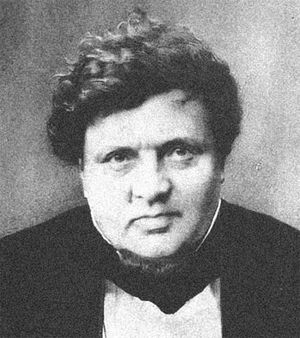Emil Aarestrup facts for kids
Carl Ludvig Emil Aarestrup (born December 4, 1800, died July 21, 1856) was a Danish poet and doctor. He is known for his unique love poems. Even though his work was not very popular when he was alive, he is now seen as one of Denmark's most important poets.
His Early Life and Career
Emil Aarestrup was born in Copenhagen, Denmark. This was a time when Denmark was involved in the Napoleonic wars. These wars caused the country to go bankrupt in 1813. However, this period is also called the Danish Golden Age, a time of great art and culture.
His father worked for the government, collecting customs fees. He was also known for enjoying life.
When Emil was seven, his parents separated. Sadly, both of them died soon after. Emil and his younger brother became orphans. They were cared for by an older woman named Marie Møller and their grandfather. Their grandfather sold tea and porcelain. Later in his poems, Aarestrup often wrote about feeling lost and lonely. These feelings might have come from losing his parents so young.
In 1819, Aarestrup began studying medicine at the University of Copenhagen. He became a doctor in 1827. That same year, he married his cousin, Caroline Aagard. She was 15 years old. They moved to Nysted on the island of Lolland, where he started his medical practice. Emil and Caroline had 12 children together.
The Aarestrup family lived in Nysted from 1827 to 1838. Then, Emil found a better job as a doctor in a different area. This new job helped with his growing family's costs, but it was still not quite enough. In 1849, he got an even bigger job. He became the District Physician in Funen, which meant he oversaw other doctors. He and his family moved one last time to Odense. He lived there for the rest of his life.
His Poems and Writings
While working as a doctor, Emil Aarestrup wrote poetry in his free time. He only published one book during his lifetime. It was called "Digte" ("Poems") and came out in 1838. Sadly, critics and the public mostly ignored it at the time. Another book, "Efterladte Digte" ("Posthumous poems"), was published after he died in 1863.
Among Danish poets, Aarestrup is known for his unique love poems. He was especially good at writing short, strong verses. He was influenced by the German poet Friedrich Rückert. Aarestrup's love poems were more focused on feelings and experiences than most other Danish poets of his time. His style was often playful, witty, and elegant. But sometimes, his poems also showed a hidden fear of death.
Some of his most famous poems include Paa Sneen (“On the Snow”), Angst (“Fear”), Til Nanna (“For Nanna”), Tidlig Skilsmisse (“Early Divorce”), and Var det Synd? (“Was It a Sin?”). He also wrote a few political poems. These poems showed his support for liberal ideas, which meant he believed in more freedom for people.
His Lasting Impact
Even though Emil Aarestrup was not famous during his own time, he is now considered one of Denmark's most important poets. His poems are still read in Denmark today. Many people see his poetry as an important step before the work of the great poet Sophus Claussen.
See also
 In Spanish: Emil Aarestrup para niños
In Spanish: Emil Aarestrup para niños
- Physician writer


